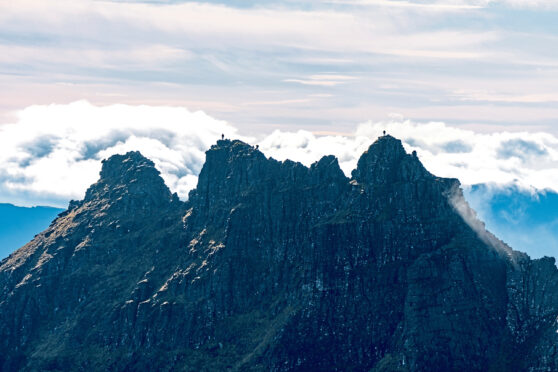
Is An Teallach the finest of Scotland’s mountains?
The grand mountain rises out of the moor south of Dundonnell and Little Loch Broom. It has two Munros – Bidein a’ Ghlas Thuill is the highest at 1,062m (3,484ft); the other, Sgurr Fiona, is slightly lower at 1,060m (3,478ft).
But there’s more to An Teallach than just that – it has eight other summits over 914m (2,999ft). Half are tightly clustered in a narrow, precipitous ridge that curves south-east from Sgurr Fiona for 2km (1.2 miles).
They form a castellated crest with towers of rock thrusting at all angles into the sky – an explosion of Tolkienesque peaks.
The traverse of An Teallach is among the very best mountain days – arguably only bettered by Skye’s Cuillin. Liathach slightly edges out An Teallach in the aesthetic stakes – but there’s more to a mountain than looks. The scrambling on An Teallach is far harder and more sustained than on both Liathach and the Aonach Eagach.
Those who aren’t keen on scrambling will be pleased to know that it’s possible to simply walk to both Munro summits. Even the traverse of the mountain can be completed – just about – by walking.
There’s a bypass path on the west side, beneath the crest, and there are a couple of sketchier parts that are quite exposed. If you’re uncomfortable on such ground, a there-and-back from Dundonnell is the best option.
Scramblers, however, will have a day they’ll never forget. Most books seem to recommend an anti-clockwise route, starting at Corrie Hallie and initially following the path that leads to Shenavall bothy – which is also a good base for the hill for those looking for an overnighter. I prefer the approach from Dundonnell, as the view when you summit Bidein a’ Ghlas Thuill is incredible. No matter how often you’ve climbed it, it’s a sight to set the pulse racing.
Pronunciation: Bid-yin a Glas Hool
(An Cha-lach); Meaning: Peak of
the green-grey hollow (the forge)
Height: 1062m (3484ft); Rank: 72
OS Landranger Map 19
Summit grid ref: NH069844 (cairn)
Nearest town: Dundonnell, almost 5km (3.1 miles) north-east, is not exactly what you’d call a town. There is a bunkhouse nearby and numerous B&Bs. The Dundonnell Hotel is an excellent base, with great food and beer. Campers and campervanners are welcome to pitch up free if you buy a meal.
Start grid ref: NH093879
Distance: 15.6km (9.7 miles)
Ascent: 1,485m (4,872ft) Time: 8hrs
Start from parking area east of Dundonnell Hotel. If possible, leave a second vehicle at Corrie Hallie – where the walk’s outward path regains the road.
Head east along road to a path that leads to the right. It zig-zags up Meall Garbh.
The path climbs again to Sron a’ Choire then swings south-east to a col below Bidein a’ Ghlas Thuill. A steep, stony ridge leads to the summit. To Sgurr Fiona, follow the crest of the ridge south-west to the bealach and then steeply to the summit. The direct scramble to the summit is easy enough.
Now comes the fun part – the scramble over the pinnacles. There are paths that bypass all difficulties – these also involve a bit of exposure. It’s better to stick to the rock. Nowhere is it ever hugely difficult for experienced scramblers, and it’s on great rock with plenty of holds. It’s a Grade 2 in parts.
The far end of the Corrag Buidhe is a graded rock climb (“Moderate”) and should not be attempted without appropriate equipment – backtrack slightly and you can pick your way down a gulley to regain the path.
The scrambling finishes all too quickly. The rest of the day is a walk, over Cadha Gobhlach and Sail Liath. From here head south-east then east, aiming for the south end of Lochan na Brathan, beyond which is the excellent path that leads from Corrie Hallie to Shenavall. Follow the track to the road.
A famous view of An Teallach is from the A832 road, on approach from Braemore Junction.
The huge mountain rears up from open moorland, its splayed, jagged pinnacles tearing into the sky.
It’s an awe-inspiring sight, particularly the pinnacles, and especially if you’re heading there with the knowledge you’ll soon be climbing them. With such an attention-grabbing view, few will give much thought to the road on which they travel.
Its past, however, marks a sad chapter in the history of the Highlands. The section from Braemore Junction to Dundonnell is known as Destitution Road, one of several across the Highlands.
It was built by starving crofting families, for food, under the direction of the Central Board for the Destitute Highlands in the late 1840s after the potato crop failed. The families worked eight hours a day, six days a week. Men got 680g (1.5lb) of oatmeal per day, women half that and children 230g (0.5lb).

Enjoy the convenience of having The Sunday Post delivered as a digital ePaper straight to your smartphone, tablet or computer.
Subscribe for only £5.49 a month and enjoy all the benefits of the printed paper as a digital replica.
Subscribe